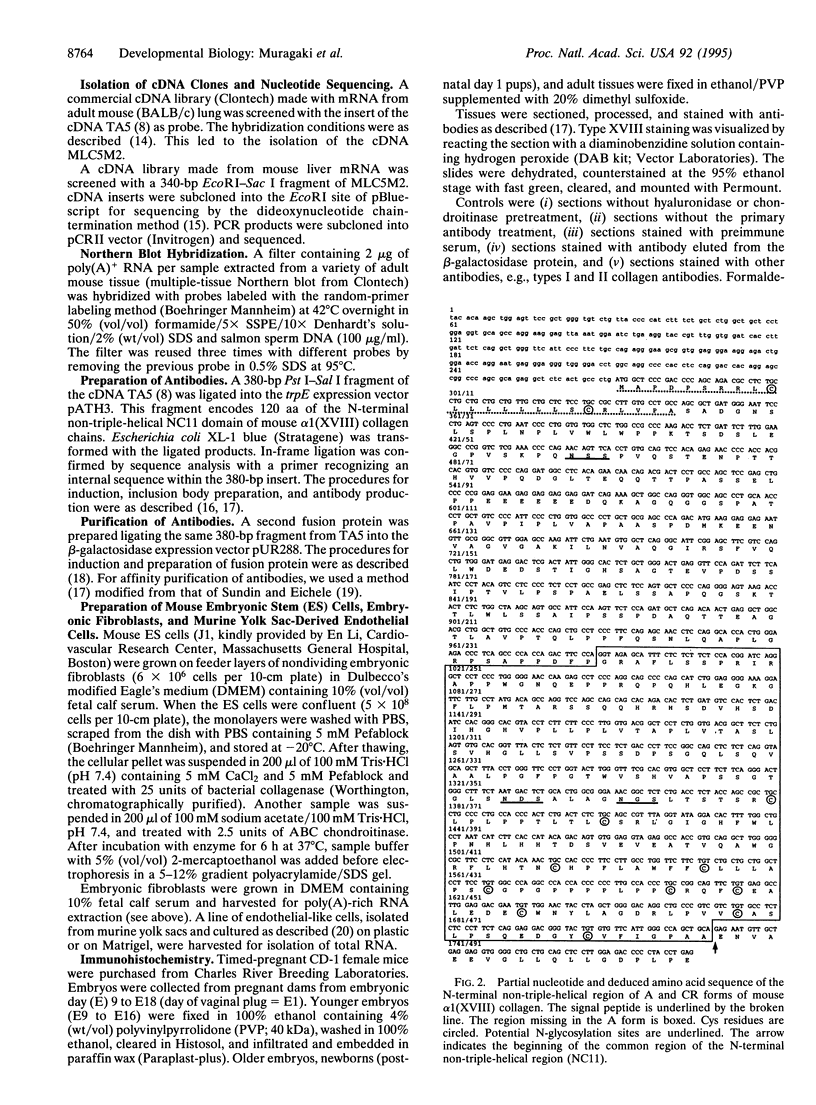Abstract
We have isolated overlapping cDNAs encoding the N-terminal non-triple-helical region of mouse alpha 1(XVIII) collagen and shown that three different variants of alpha 1(XVIII) collagen exist. Each of the three variants shows characteristic tissue-specific expression patterns. Immunohistochemical studies show positive staining for alpha 1(XVIII) collagen along the basement membrane zones of vessels in the intestinal villi, the choroid plexus, skin, liver, and kidney. Thus, we conclude that alpha 1(XVIII) collagen may interact (directly or indirectly) with components in basement membrane zones or on the basal surface of endothelial/epithelial cells.
Full text
PDF




Images in this article
Selected References
These references are in PubMed. This may not be the complete list of references from this article.
- Abe N., Muragaki Y., Yoshioka H., Inoue H., Ninomiya Y. Identification of a novel collagen chain represented by extensive interruptions in the triple-helical region. Biochem Biophys Res Commun. 1993 Oct 29;196(2):576–582. doi: 10.1006/bbrc.1993.2288. [DOI] [PubMed] [Google Scholar]
- Adler P. N., Vinson C., Park W. J., Conover S., Klein L. Molecular structure of frizzled, a Drosophila tissue polarity gene. Genetics. 1990 Oct;126(2):401–416. doi: 10.1093/genetics/126.2.401. [DOI] [PMC free article] [PubMed] [Google Scholar]
- Chan S. D., Karpf D. B., Fowlkes M. E., Hooks M., Bradley M. S., Vuong V., Bambino T., Liu M. Y., Arnaud C. D., Strewler G. J. Two homologs of the Drosophila polarity gene frizzled (fz) are widely expressed in mammalian tissues. J Biol Chem. 1992 Dec 15;267(35):25202–25207. [PubMed] [Google Scholar]
- Chomczynski P., Sacchi N. Single-step method of RNA isolation by acid guanidinium thiocyanate-phenol-chloroform extraction. Anal Biochem. 1987 Apr;162(1):156–159. doi: 10.1006/abio.1987.9999. [DOI] [PubMed] [Google Scholar]
- Dumont D. J., Gradwohl G. J., Fong G. H., Auerbach R., Breitman M. L. The endothelial-specific receptor tyrosine kinase, tek, is a member of a new subfamily of receptors. Oncogene. 1993 May;8(5):1293–1301. [PubMed] [Google Scholar]
- Hopkinson S. B., Riddelle K. S., Jones J. C. Cytoplasmic domain of the 180-kD bullous pemphigoid antigen, a hemidesmosomal component: molecular and cell biologic characterization. J Invest Dermatol. 1992 Sep;99(3):264–270. doi: 10.1111/1523-1747.ep12616615. [DOI] [PubMed] [Google Scholar]
- Hulmes D. J. The collagen superfamily--diverse structures and assemblies. Essays Biochem. 1992;27:49–67. [PubMed] [Google Scholar]
- Kleid D. G., Yansura D., Small B., Dowbenko D., Moore D. M., Grubman M. J., McKercher P. D., Morgan D. O., Robertson B. H., Bachrach H. L. Cloned viral protein vaccine for foot-and-mouth disease: responses in cattle and swine. Science. 1981 Dec 4;214(4525):1125–1129. doi: 10.1126/science.6272395. [DOI] [PubMed] [Google Scholar]
- Mayne R., Brewton R. G. New members of the collagen superfamily. Curr Opin Cell Biol. 1993 Oct;5(5):883–890. doi: 10.1016/0955-0674(93)90039-s. [DOI] [PubMed] [Google Scholar]
- Muragaki Y., Abe N., Ninomiya Y., Olsen B. R., Ooshima A. The human alpha 1(XV) collagen chain contains a large amino-terminal non-triple helical domain with a tandem repeat structure and homology to alpha 1(XVIII) collagen. J Biol Chem. 1994 Feb 11;269(6):4042–4046. [PubMed] [Google Scholar]
- Oh S. P., Griffith C. M., Hay E. D., Olsen B. R. Tissue-specific expression of type XII collagen during mouse embryonic development. Dev Dyn. 1993 Jan;196(1):37–46. doi: 10.1002/aja.1001960105. [DOI] [PubMed] [Google Scholar]
- Oh S. P., Kamagata Y., Muragaki Y., Timmons S., Ooshima A., Olsen B. R. Isolation and sequencing of cDNAs for proteins with multiple domains of Gly-Xaa-Yaa repeats identify a distinct family of collagenous proteins. Proc Natl Acad Sci U S A. 1994 May 10;91(10):4229–4233. doi: 10.1073/pnas.91.10.4229. [DOI] [PMC free article] [PubMed] [Google Scholar]
- Oh S. P., Warman M. L., Seldin M. F., Cheng S. D., Knoll J. H., Timmons S., Olsen B. R. Cloning of cDNA and genomic DNA encoding human type XVIII collagen and localization of the alpha 1(XVIII) collagen gene to mouse chromosome 10 and human chromosome 21. Genomics. 1994 Feb;19(3):494–499. doi: 10.1006/geno.1994.1098. [DOI] [PubMed] [Google Scholar]
- Rehn M., Hintikka E., Pihlajaniemi T. Primary structure of the alpha 1 chain of mouse type XVIII collagen, partial structure of the corresponding gene, and comparison of the alpha 1(XVIII) chain with its homologue, the alpha 1(XV) collagen chain. J Biol Chem. 1994 May 13;269(19):13929–13935. [PubMed] [Google Scholar]
- Rehn M., Pihlajaniemi T. Alpha 1(XVIII), a collagen chain with frequent interruptions in the collagenous sequence, a distinct tissue distribution, and homology with type XV collagen. Proc Natl Acad Sci U S A. 1994 May 10;91(10):4234–4238. doi: 10.1073/pnas.91.10.4234. [DOI] [PMC free article] [PubMed] [Google Scholar]
- Rehn M., Pihlajaniemi T. Identification of three N-terminal ends of type XVIII collagen chains and tissue-specific differences in the expression of the corresponding transcripts. The longest form contains a novel motif homologous to rat and Drosophila frizzled proteins. J Biol Chem. 1995 Mar 3;270(9):4705–4711. doi: 10.1074/jbc.270.9.4705. [DOI] [PubMed] [Google Scholar]
- Sanger F., Nicklen S., Coulson A. R. DNA sequencing with chain-terminating inhibitors. Proc Natl Acad Sci U S A. 1977 Dec;74(12):5463–5467. doi: 10.1073/pnas.74.12.5463. [DOI] [PMC free article] [PubMed] [Google Scholar]
- Sundin O. H., Eichele G. A homeo domain protein reveals the metameric nature of the developing chick hindbrain. Genes Dev. 1990 Aug;4(8):1267–1276. doi: 10.1101/gad.4.8.1267. [DOI] [PubMed] [Google Scholar]
- Vuorio E., de Crombrugghe B. The family of collagen genes. Annu Rev Biochem. 1990;59:837–872. doi: 10.1146/annurev.bi.59.070190.004201. [DOI] [PubMed] [Google Scholar]
- van der Rest M., Garrone R. Collagen family of proteins. FASEB J. 1991 Oct;5(13):2814–2823. [PubMed] [Google Scholar]







